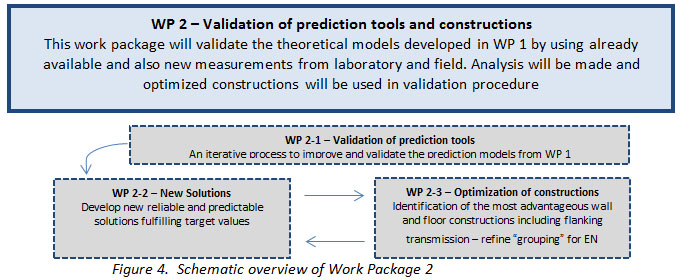WP2 first task is to continuously validate the tools developed in WP 1 using construction examples from WP 3, grouped due to building system, and send back updated information about their performance and hence create an iterative process. As the validation procedure is running, the second task will develop new solutions that fulfil target values from WP 1. The third task is then to optimize constructions and deliver new input regarding reliable modern examples to WP 3.
Hence, in this work package the main focus is to continuously validate the developed prediction tools in WP 1 on a number of constructions and develop examples of new and optimized solutions. The scope is to use intelligent solutions with limited use of additional, non-wooden materials to reduce the carbon foot-print. The campaign will include the following:
- The prediction tools models in the high and low frequency range will be used on selected constructions grouped within WP 3. Relevant descriptors stated in task 1 in WP 1 will be taken into account including full frequency range. The validation will be an iterative process between the development of the prediction tools in WP 1 and the results from this analysis
- Experiences will be used to develop new solutions fulfilling the new target values. Identification of innovative industrialized constructions will be prepared in conjunction with the project partners in order to secure its ability to be built efficient in practice. Ideas from the different countries involved and the different building constructions will be discussed. Building of proposed floor and wall constructions will be carried out according to best practice and with the SME’s
- Results and experiences from previous mentioned sub-tasks will be combined to make suggestions on further optimized constructions based on predictions and refine the « grouping” to fit in EN standards [19]. The prediction tools will be used to prepare the most advantageous optimized solutions, including « grouping” in order to cover a wide range of structural solutions, including the junctions between structural elements.
In summary, the junctions / couplings between building parts is very important since there are no clear or specified models available for a huge amount of different junctions [27-30]. The couplings between elements contribute to damping, stiffness as well as sound transmission.
An in-depth analysis will be conducted of some representative couplings and how these can be interpreted, modeled and improved, forming basis for verified prediction model for lightweight structures according to proposals from WP 1 and for new optimized constructions. And finally, include an adaptation of the model (junctions and similar) in order to fit into the European standard series EN 12354.
[27] Homb, A. Low frequency sound and vibrations from impacts on timber floor conÂstrucÂtions. Doctoral theses at NTNU, 2006:132. IME Faculty, Dep. of Electronics and TeleÂcommunications. Trondheim, Norway 2006.
[28] Homb, A. , Austnes, J.A. Experiences with sound insulation for cross-laminated timber floors. Proceedings, Baltic Nordic AcouÂstical Meeting, Bergen Norway, 10-12. May 2010.
[29] Homb, A. Experiences with impact measurements at low frequencies. Presentation at COST FP0702 meeting, Delft, Netherland, 4th Nov. 2010.
[30] Homb, A. Flanking transmission measurements in a cross laminated timber element building. Proceedings, Euronoise, Prague Czechoslovakia, 10-13. June 2012.

